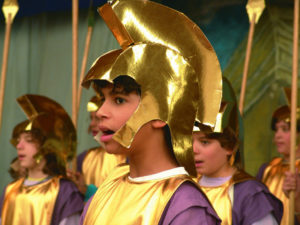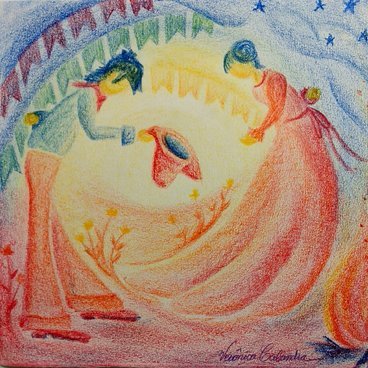 The 11 year old child
The 11 year old child
By Cristina Maria Brigagão Abalos, Dora Regina Zorzetto Garcia and Vilma Lúcia Furtado Paschoa.
The 11-year-old's relationship with Nature is intensified by the presentation of the world of plants. From observation, the educator can lead her to reflect on this silent universe that goes beyond the visible, beyond matter, with its laws of development, geometric shapes and metamorphoses. Starting from the relationship between the vegetable landscape and its environment, for example, the perception of Brazil's regional diversity emerges. Through this approach, there is a way to investigate natural and sociocultural differences.
Students can be introduced to the environment and atmosphere of ancient cultures – India, Persia, Mesopotamia, Egypt and Greece – through accounts of these civilizations and their respective mythologies, and then they realize that the men of that time did not think, feel and act. like us. They see how men stopped being nomads and settled in the land, raising herds, cultivating crops and forming small villages. The educator can also address the polarity between Sparta and Athens, both in geography and in legislation, education, customs, etc. and tell about the organization of the famous Olympic games, which have survived until our days. It is your responsibility to guide the yearning for hero worship, so strong at this stage, so that students do not become fixated on artificial idols. Poetry, when associated with historical narratives, enriches them and fills them with meaning. The vigor of language grows in chorus speech, where varied rhythms such as dactyls, anapestos* and others have harmonizing effects.
* See about these rhythms in the book Learning with Poetry, pages 55 to 67.
In this age group of development, the goal of language is to increasingly sediment the child's relationship with time and space. It seeks to awaken a sensitivity to the style. Individual expression is encouraged, either orally or in writing.
THE THEATER FOR 11-YEAR-OLD CHILDREN
The choice of play for an 11-year-old child encompasses new and varied elements, such as: longer text, larger dialogues, more scenes in which the characters play together and move more.
As a practical example, the play “Demeter and Persephone” was chosen. The experience begins when the teacher tells the story of the play based on ancient Greek myth. Chorus verses can be said every day at the beginning of rehearsals. At the same time, students can make drawings, paintings and essays, projecting their experiences. Then, with the text in hand, the students, in small groups, will assemble parts of scenes to be presented in the larger group, as suggestions. The teacher interferes by making the necessary corrections and adjustments. It is observed that the student at the age of 11 is capable of being a more effective and engaged collaborator in the process of assembling a piece. Even so, ultimately, it is the teacher who defines the roles, since, from his experience, he can perceive which role is most suitable for a student.
In the text “Demeter and Persephone”, the language is theatrical, rhythmic and poetic, to the point of sounding like a melody. There is a cadence that flows from speech to gesture, to walking, to movement on stage, which can be intensely harnessed. In the passage spoken in chorus “Salve Demeter, Mother Earth who takes care of all plants”, children can move in the rhythm of the hexameter, formed by metric feet called dactyls (long-short-short), in which a long step followed by two short ones. The long step falls on stressed syllables and reinforces consonants. Such a rhythm increases concentration and comprehension of the text. Thus, the child can experience it with the entire choir, which acts more deeply.
In addition to the music suggested in the play, melodies and sound effects can be used to accompany the mood, through instruments such as flutes, cymbals, small harps, zithers, etc., as long as their sound does not interfere with the children's voices.
In the process of assembling a piece like this, it is essential that the relationship and interaction of the man of that time with nature and his experience of polarities: light and shadow, expressed by Zeus and Hades, abundance and scarcity , fertility and sterility, interiorization and exteriorization, winter and summer.
There are countless possibilities to experience such polarities. Here we suggest some practices that could be the starting point for the creation of new experiences.
Through music, for example, using major and minor keys, highs and lows, different rhythms and instruments, students can perceive these contrasts.
Another resource is to make the students, wrapped in light and clear fabrics, experience the text that talks about nymphs and plants. With heavy and dark fabrics, we can sensitize them to the atmosphere of the earth without Demeter: “Hard is the fate of the earth…” In both situations, let the students express freely, through gestures, walking and mime, his feelings, sometimes of joy and lightness, sometimes of disconsolation and deep sorrow. Also with dark fabrics, shuffling gait, heavy gestures, bowed heads, sad faces, one can experience Demeter's pain at losing her daughter.
From there, you have the basic elements to compose the costume in the Greek style, with few ornaments, perhaps wreaths of flowers or leaves to characterize the “plants”, silver tiaras for the nymphs, an armful of corncobs for Demeter and two different covers for Persephone, showing her time with Hades (winter) and time with her mother Demeter (summer).
There is no need for a scenario itself. The atmosphere can be created with the use of wooden platforms: at a higher level, light cloths are raised irregularly, forming folds, volumes and transparencies, thus characterizing Olympus; in a corner of the stage, the same resources are used to compose the world of Hades, but using darker colors. The middle plane, Earth, can be below and in front of Olympus. Some lighting effects can enhance the contrasts of a simple scene.
With other pieces of this age group, try to make the assembly using an idea just similar to this example given. But, don't hold on to the piece chosen here as an example.



